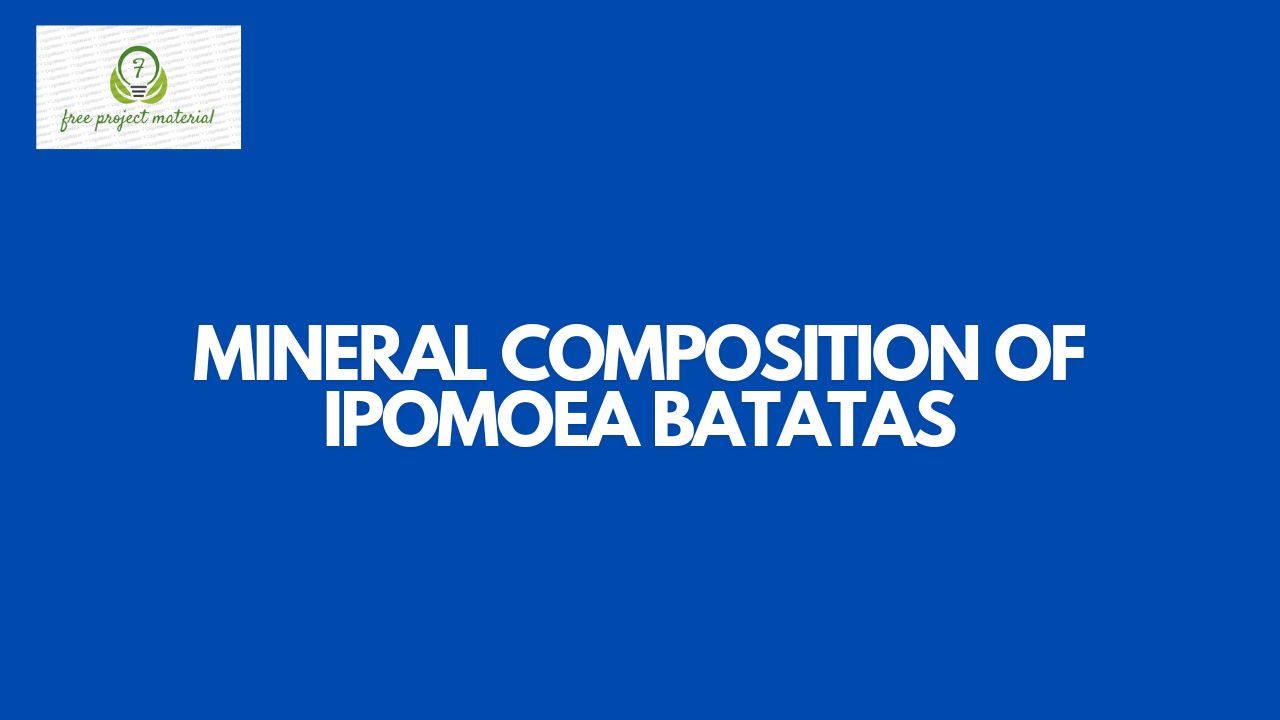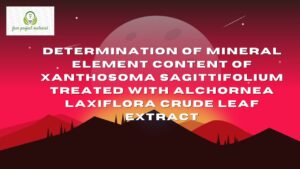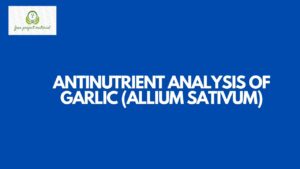ABSTRACT
This study was designed to analyze the mineral composition of Ipomoea batatas. The sample were analyzed using standard analytical procedure. The result of the analysis revealed the following: Sodium (21.14±0.12), magnesium (13.51±0.05), Calcium (10.52±0.71), Potassium (5.12±0.02), Phosphorus (2.94±0.80). The highest macro–element content of Ipomoea batatas analyzed was sodium and lowest was potassium. The presence of these macro-element in Ipomoea batatas suggest that it is suitable and good food in the management of impoverishment disease such as hypertension and diabetes.
TABLE CONTENT
TITLE PAGE – – – – – – – – i
CERTIFICATION – – – – – – – ii
DEDICATION – – – – – – – – iii
ACKNOWLEDGEMENT – – – – – – iv
ABSTRACTS – – – – – – – – v
TABLE OF CONTENT – – – – – – vi-viii
CHAPTER ONE: INTRODUCTION
1.1 Background of the Study – – – – – – 1-4
1.2 Aim and Objectives of the Study – – – – 5
1.3 Scope and Limitation of the Study – – – – 5
1.4 Definition of Terms – – – – – – 5
CHAPTER TWO: LITERATRUE REVIEW
2.1 Description of Ipomoea batatas – – – – – 6-7
2.2 Origin of Ipomoea batatas – – – – – – 8-9
2.3 Classification of Ipomoea batatas – – – – 9
2.4 Cultivation of Ipomoea batatas – – – – 9-12
2.5 Nutrient Content of Ipomoea batatas – – – 12-15
2.6 Culinary Uses – – – – – – – 15
2.6.1 Uses in Africa – – – – – – – 15-17
2.6.2 Uses in Asia – – – – – – – 17-19
2.7 Biochemical Functions of Mineral
Element In Human and Animal – – – – 20
2.7.1 Calcium – – – – – – – – 20-22
2.7.2 Potassium – – – – – – – – 22-23
2.7.3 Cobalt – – – – – – – – 24-25
2.7.4 Magnesium – – – – – – – – 25-26
2.7.5 Copper – – – – – – – – 27-29
2.7.6 Zinc – – – – – – – – – 30-31
2.7.7 Manganese – – – – – – – – 31-33
2.8 Processing of Ipomoea batatas – – – – – 33-35
2.9 Health Benefits of Ipomoea batatas – – – – 36-39
CHAPTER THREE: MATERIALS AND METHOD
3.1 Materials – – – – – – – – 41
3.2 Sample Collection/Treatment – – – – – 41-42
3.3 Digestion of the Sample – – – – – – 42
3.4 Elemental Analysis – – – – – – 43
CHAPTER FOUR: RESULT AND DISCUSSION
4.1 Result – – – – – – – – 44
4.2 Discussion – – – – – – – – 44-46
CHAPTER FIVE: CONCLUSION AND RECOMMENDATION
5.2 Conclusion – – – – – – – – 47
5.3 Recommendation – – – – – – – 48
References
CHAPTER ONE
INTRODUCTION
1.1 Background of the Study
One of the world’s greatest challenges is to secure adequate food that is healthy, safe and of high quality for all (Hunter and Fanzo, 2013). Among the different type of malnutrition, ‘Hidden hunger’, a deficiency of micronutrients vitamins and minerals is particularly severe, and affects as many as 3 billion people globally (FAO, 2013). This type of malnutrition and obesity frequently exist side by side, causing a ‘double burden’ (FAO, 2013). Minerals are naturally occurring chemical elements the body uses to help perform certain chemical reactions (Ikwechi and Ikwechi, 2009), and they are essential for the normal functioning of muscles, heart, nerves, and in the maintenance of body fluid composition as well as for building strong bones (Chaney, 2006).
Traditionally, the diets of early population were based on traditional food with wide range of crops including Neglected and Underutilized Species-NUS which led to healthier population, holistic life, free from most of the modern day diseases. With recent wave of economic depression and its attendant effect on the purchasing power of the population of less developed nations, it has become obvious that the local food stuffs will play increasing role in the food, nutrition and health security of the rural people and the increasing urban poor (Aja et al., 2010). In addition, recent international fora have emphasized the importance of biodiversity for food security and health and its central role in household food security and income generation (Bisselua and Niang, 2013). Among the local food, sweet potato (Ipomoea batatas (L.) Lam.) is estimated to play a vital role in combating the food shortages and malnutrition (Naskar et al., 2008) due to its contents of various kinds of physiologically functional components in both roots and leaves, which have the potential to maintain human health and mitigate the diseases (Yoshimoto, 2010). As a staple food in most poor region of the continent, it is becoming increasingly recognized as an important crop in Africa because of its relatively cheap price compared to cereals and others roots and tubers crops in the continent (Tomlins et al., 2010). Sweet potatoes are a nutritious food, low in fat and protein, but rich in carbohydrate. Both tubers and leaves are good sources of antioxidants (Teow et al., 2007), fiber, zinc, potassium, sodium, manganese, calcium, magnesium, iron, and vitamin C (Antia et al., 2006).
According to Chaney (2006), in the class of micro nutrients, minerals can be divided into two groups including major minerals (calcium, chloride, phosphorus, potassium, sodium, sulphur, and magnesium) and trace minerals (iodine, iron, zinc, selenium, fluoride, chromium, copper, molybdenum, and manganese). Therefore, the body needs larger amounts of major minerals than trace minerals; although trace minerals play significant role in good health maintenance. Minerals salts play a major role in the maintenance of individual s health. According to Adjatin et al. (2013), distorted enzymatic activity and poor electrolyte balance of the blood fluid are related to inadequate calcium, potassium and magnesium as they are the most required elements of living cells. Also deficits in iron, zinc, and calcium can have far reaching adverse consequences on growth, health, and cognitive development during childhood (Gibson et al. 2010).
There is more recent evidence that proves that a varied diet is beneficial (Tucker, 2001; Bisselua and Niang, 2013) for improved nutritional status of people particularly micronutrient density of diet. In this context a highly nutritious neglected and underutilized specie like sweet potato (often considered as poor man s food and relegate to the second-rate food), when usually part of a diverse diet may help to combat malnutrition, hidden hunger, overweight and obesity. Hence, for diversification of the utilization of the crops, there is need to evaluate it nutritional composition, it physico-chemical properties as well as it technological aptitude as it has been done for cassava (Sanoussi et al., 2015). Preliminary study on ten (10) sweet potato cultivars was focused on proximate composition, starch, total and reducing sugars content for better orientation of the existing local varieties in terms of utilization towards the appropriate industrial process (Sanoussi et al., 2015).
1.2 Aim and Objectives of the Study
Aim
The aim of this study is to evaluate the mineral composition of Ipomoea batatas (sweet potato).
Objectives
The objectives of this study are:
To determine the macro-mineral composition of Ipomoea batatas
To discuss the implication of the findings
1.3 Scope and Limitation of the Study
This study was designed to analyzed the macro-mineral content in Ipomoea batatas, due to Financial and time constraint, lack of some instrument this research was however limited .
1.4 Definition of Related Terms
Malnutrition: lack of proper nutrition cause by not having enough to eat, not eating enough of the right meal or being unable to use the food that one eat.
Neglected: To pay no attention or too little attention to; disregard or slight;
Antioxidant: a substance that inhibit oxidation, especially one used to counteract the deterioration of stored food, product.
Ipomoea batatas: is a dicotyledonous plant that belongs to the bindweed of morning glory family.



